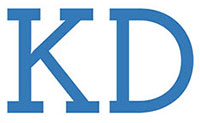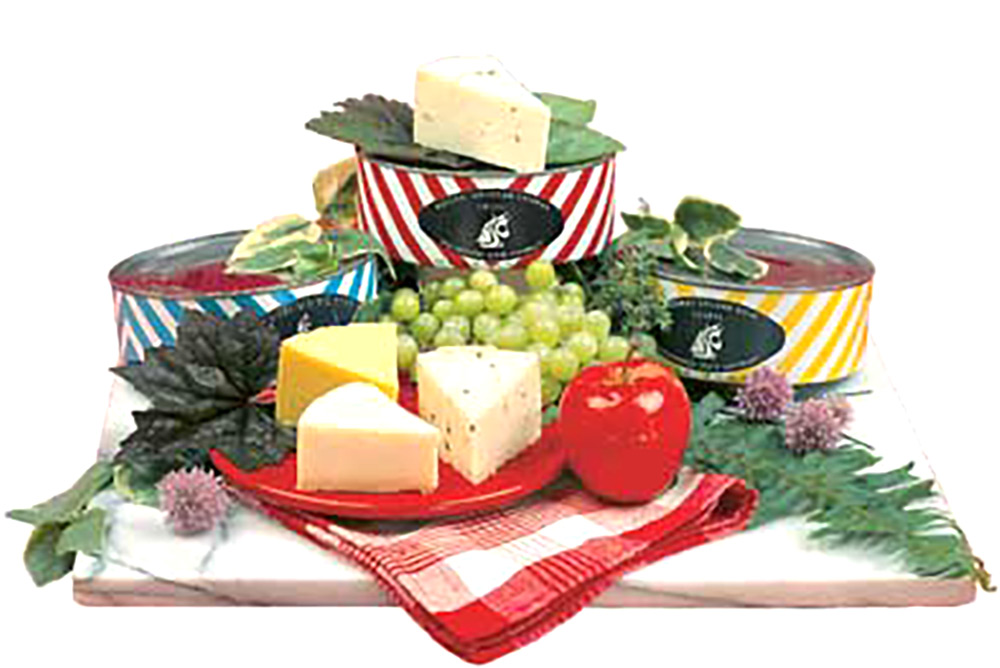Kitchen Detail’s Nancy Pollard is lucky to have some great colleagues. Here, Victoria Sackett, her editor, writes about a Northwest Pacific specialty.
After owning one of the best cooking stores in the US for 47 years—La Cuisine: The Cook’s Resource in Alexandria, Virginia—Nancy Pollard writes Kitchen Detail, a blog about food in all its aspects—recipes, film, books, travel, superior sources, and food-related issues.
 REMEMBERING my days as a Capitol Hill receptionist, I had a sudden hankering for canned cheese. Ugh, right? Ugh indeed, if you’re thinking Cheez Whiz-ish, schoolbus-hued squiggles oozing from a can with a spray nozzle. But not that. What I was remembering was creamy, sharp, white aged cheddar, complete with crunchy bits of tyrosine and notes of Parmesan and Gouda. Cougar Gold cheese is a treasured creation produced for 60 years by Washington State University’s Creamery and its food science students. It’s an ordinary wheel of cheddar, but vacuum-packed in a flat can, like tuna but bigger.
REMEMBERING my days as a Capitol Hill receptionist, I had a sudden hankering for canned cheese. Ugh, right? Ugh indeed, if you’re thinking Cheez Whiz-ish, schoolbus-hued squiggles oozing from a can with a spray nozzle. But not that. What I was remembering was creamy, sharp, white aged cheddar, complete with crunchy bits of tyrosine and notes of Parmesan and Gouda. Cougar Gold cheese is a treasured creation produced for 60 years by Washington State University’s Creamery and its food science students. It’s an ordinary wheel of cheddar, but vacuum-packed in a flat can, like tuna but bigger.
Every Christmas back in the 1970s, Senator Henry M. “Scoop”Jackson’s office received a few cans from grateful constituents, and I once managed to snag one. Bliss. Nothing in my Kraft-saturated youth had tasted anything like Cougar Gold.
Four decades after those memorable first bites, I worried Cougar Gold might have disappeared. I was delighted to find that the Pullman, Washington, campus is cranking out 250,000 cans of cheese a year, now producing it in eight flavors, including Dill Garlic, Sweet Basil, and Crimson Fire (“created on demand for our Hot Pepper lovers who wanted more kick”). Cougar Gold is the overwhelming favorite, accounting for 80 percent of sales.
I ordered an almost-two-pound can of the classic flavor for a Kitchen Detail family tasting to enlighten the uninitiated. The first step was to explain why the can.
The Way of Curds
WSU began as an agricultural college in the late 19th century, eventually with its own dairy and creamery that earned it the nickname “Moo U.” They’ve created their own magical strain of bacterial culture that has been nurtured for decades, plus an element that helps keep cans from collecting carbon dioxide. According to WSUs online history page, “In the late 1930s, the Creamery became interested in different ways to store cheese. Cans seemed to be the best option, because plastic was not yet invented and wax cracked (enabling contamination). In the 1940s, the US government and American Can Company funded WSU’s research to find a way to successfully keep the cheese in tins. One of the cheeses resulting from the research was so wonderful that it was dubbed “Cougar Gold®,” after [the school’s cougar mascot and] Dr. N. S. Golding, one of the men involved in this research. Canned Cougar Gold® has been in production ever since.” Apparently the military was interested in the possibilities for canned cheese to feed World War II troops, but the need to refrigerate even the unopened containers scuttled that idea. The cheese is aged for a year before release and, refrigerated, can last forever.
creamery that earned it the nickname “Moo U.” They’ve created their own magical strain of bacterial culture that has been nurtured for decades, plus an element that helps keep cans from collecting carbon dioxide. According to WSUs online history page, “In the late 1930s, the Creamery became interested in different ways to store cheese. Cans seemed to be the best option, because plastic was not yet invented and wax cracked (enabling contamination). In the 1940s, the US government and American Can Company funded WSU’s research to find a way to successfully keep the cheese in tins. One of the cheeses resulting from the research was so wonderful that it was dubbed “Cougar Gold®,” after [the school’s cougar mascot and] Dr. N. S. Golding, one of the men involved in this research. Canned Cougar Gold® has been in production ever since.” Apparently the military was interested in the possibilities for canned cheese to feed World War II troops, but the need to refrigerate even the unopened containers scuttled that idea. The cheese is aged for a year before release and, refrigerated, can last forever.
According to Nora Singley on theKitchn blog, the creamery is entirely self-funded, with all revenue going to its operation, student salaries, and research. A portion of the profits goes to provide educational support to university students enrolled in food studies. They make the cheese, market it, and sell it in the campus store.
Winning Silver and Gold
Cougar Gold and its brethren have been hailed for their excellence. In 1993, the American Cheese Society awarded Cougar Gold with a blue ribbon, and in 1995 the cheese earned the United States Cheese Champion silver medal. Cougar Gold later earned a silver medal at the 2000 World Cheese Awards and a gold medal at the 2006 World Cheese Awards.
Society awarded Cougar Gold with a blue ribbon, and in 1995 the cheese earned the United States Cheese Champion silver medal. Cougar Gold later earned a silver medal at the 2000 World Cheese Awards and a gold medal at the 2006 World Cheese Awards.
For the KD family tasting event, Nancy Pollard opted for cheese on baguettes and crackers, plus a version of chile con queso that puts the traditional Velveeta/Ro-Tel combo to shame. Moo U hasn’t lost its touch. Cougar is still gold.
Chile Con Queso

- 5 tablespoons vegetable oil (I have substituted lard and even bacon grease)
- 1½ cups (375ml) thinly sliced white onions
- 1 cup (250ml)thinly sliced tomatoes (I remove the seeds and liquid)
- 15 Green Anaheim chiles, charred, peeled, and cut into strips without removing seeds (I have used seeded strips of jalapeño because I use this mixture as a dip)
- Fine sea salt to taste
- ¾ cup (185ml) whole milk
- 3 tablespoons water (I have also used beer)
- 8 ounces (225gr) Chihuahua, Asadero or Muenster cheese, thinly sliced (I used Cougar Gold)
- Heat the oil in a deep skillet and cook the onion over low heat until translucent (you want them soft but not browned)
- Add the tomatoes and chile strips (I have diced these if making it solely as a dip) and season with salt.
- Cover and cook over medium heat for about 5 minutes.
- Add the milk and water and let the mixture cook for another few minutes.
- Just before serving, add the cheese to the chile mixture and serves as soon as the cheese has melted and the mixture is smooth.
- You can cut up leftover flour or corn tortillas into triangles and fry them in lard or oil.
- The mixture makes a great grilled cheese sandwich too.
- Add it as a topping to a pulled-pork sandwich instead of a barbecue sauce.


